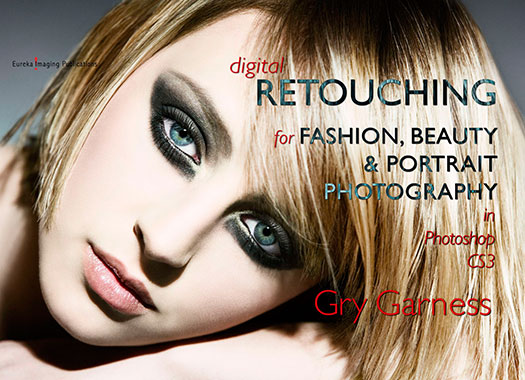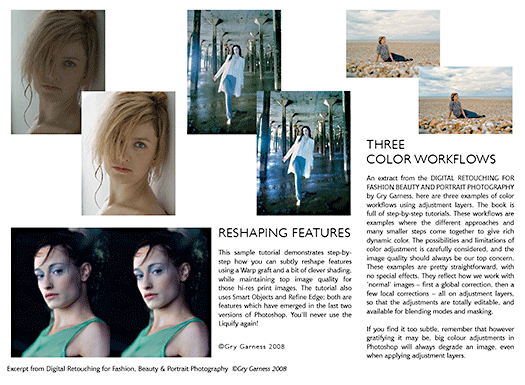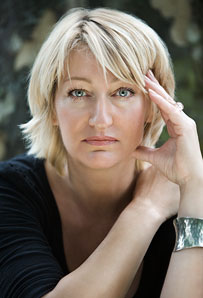Monday, 19 January 2009
Model Health Inquiery
11 July 2007: Baroness Denise Kingsmill, Chairman of the Independent Model
Health Inquiry, established by the British Fashion Council to look into the health
of models on the catwalks at London Fashion Week, today published the
Inquiry’s Interim Report containing outline recommendations to ensure the
industry behaves responsibly and in the best interests of those models who help
make a success of London Fashion Week.
Glossy magazines face airbrush ban
www.tinyurl.com/9zqdv7
Now fashion mags make models 'fatter'
By Roya NikkhahLast Updated: 1:57AM BST 13 Apr 2008 www.tinyurl.com/7rjgkf
Campaign: Photoshop and Advertising
Campaign: Photoshop and Advertising Is it benign and irrelevant, or damaging and indefensible?
in Media Action investigates Photoshopping and advertising
Submitted by nicole on Thu, 11/27/2008 - 08:01
Is photoshopping benign and irrelevant, or damaging and indefensible?Media Action's current project is looking into the practices of photo-retouching in advertising. We want to know if magazines should be allowed to graphically enhance photos that accompany ads for anti-aging creams. Check out our campaign page for me information, and get in touch if you'd like to get involved.
However this site does not go any further as yet.
Retouching physical truth creates deadly
www.tinyurl.com/8v7qfh
Computer-enhanced images trick women into trying to attain artificial perfection
April 21, 2008
SHARI GRAYDON
Women are dying to look perfect.
Faking it and the Women's Forum Australia
2. To conduct and sponsor research about social, cultural, health and economic issues relevant to women;
3. To provide education to women and men about social, cultural, health and economic issues relevant to women;
4. To promote the equal participation and contribution of women and men in the work place and public life;
5. To promote a positive balance for women and men between family commitment and participation in the work force;
6. To mentor women in their contribution to public life;
7. To promote initiatives that work for improvements in the lives of all women, in particular women from disadvantaged and marginalised backgrounds including women with physical and intellectual disabilities, women with mental illness, refugee and migrant women and indigenous women; and To empower women in their contribution to media and public debate and the formation of social policy.
What really goes on when young women pick up a glossy women's lifestyle magazine? What have psychologists, sociologists and other researchers found out about how they affect women's health and wellbeing? What messages are really being sent through these magazines? How do advertising images affect us? What do magazines have to do with eating disorders?For all this and more, in a very readable magazine format, order your copy online now!

This is a source that would have been very useful to my project but would have cost me about £15 to buy and ship it from Austrailia and I would not have gotten it in time :(
I do however have access to one chapter of the magazine at www.tinyurl.com/7c36ln
Chasing an illusion: young women and magazines
It talks about the effetcs of media images on women in general and specifically the fact that these images are airbrushed and unrealistic, with headings of ;
"media images"- WFA has also produced a mini documentary about society's built in messages that you have to be thin and sexy to be acceptable. It's available on You Tube.
"pyschological harm" A recent survey found a quarter of Australian teenage girls would get plastic surgery if they could - and 2 per cent already had. The study of 4,000 girls aged 11 to 18 found most were unhappy with their bodies.
and "not the real thing" "They are aspiring to unattainable, sexualised, digitally enhanced images of models and celebrities - women airbrushed beyond recognition."
Focus group results
Both groups were 50/50 male and female- 2 groups of 12, one media savvy one not. All aged either 17 or 18.
1. all said they were aware that retouching is used in advertising and the media
2. 3 male and 3 femlae media savvy said they were aware of how much retocuhing could do compared with only 3 overall from the other group, 1 male, 2 female. So 50% compared to 25%
3. most females from both groups said they disliked the industry for this, that it was fake and misleading and made them feel bad about them selves. considerably fewer males agreed.
4. 100% from both groups said this was a negative thing about the industry
5. 80% compared to 25% of the non savvy students thought people were genrally aware fo this, all agreeing that younger kids, 10-13 would probably not be aware and very vulnerable to the media's messages
6.100% of al groups said they think thats this can lead to self esteem ESPECIALLY if your not aware of it
7. over 50% of both groups found the image of faith fill most shocking, with the german teen mag coming in second as such a young girl had been transformed into a sexual object.
These two focus groups have been really useful, showing opinions of my peers, however groups were small and not very reprentative espeially of age, allthough I made sure to get a balance of genders.
They found the "look but don't touch, where am I?" clip very shocking too.
Wednesday, 14 January 2009
Dove
www.tinyurl.com/9y5egr this is the dove section on the "unilever" site, not the dove home site but has links to all of Dove's sites including their home site. there is information about all of their campaings and links to them. e.g. the Evolution advert, this one i feel is specific to my project as it shows the effects retouching has as well as the effects of hair, make-up and lighting. when used collaboritively and professionally can have very dramatic, unrealistic and misleading representations of beauty.
www.tinyurl.com/ylzku6
Dove have many interesting and shocking statistics on this site to do with beauty;
Did you know...
just 12 % of women are very satisfied with their physical attractiveness
only 2 % of women describe themselves as beautiful
68 % strongly agree that the media sets an unrealistic standard of beauty
75 % wish the media did a better job in portraying the diversity of women's physical attractiveness, including size and shape, across all ages .
Other Dove adverts promoting self esteem are Onslaught;
and True Colours
Dove PR0-age campaign
Interview with Gry Garness
1) What kind of work do you normally do? E.g. do people send you their own pictures to adjust, your own photography, advertisements etc
comissioned work for industry photographers, cd sleeves, book covers, advertising and mag features, mainly music and celebs
2) What kind of retouching do you normally do? E.g. lighting corrections, shadows, complexion, or any kind of body adjustments?
Beauty-skin to a previously agreed level, usually absolute perfection
older males, refine the eye bags and lines "aim to make the person appear how they do in real life" camera can be bad to the subject particularly wide angle lenses; i tone down light, lighten dark areas and make colours more vibrant
3) Would you say retouching in general is usually quite subtle work which gets bad press, or does a lot of excessive work e.g. making the person unrecognisable as themselves occur quite frequently?
good retouching is always subtle
4) Who is it that decides how the finished product should look? The private customer or if working on a bigger scale project the art director?
the client has the final say, but the photographer first and then the art-director
5) Have you ever made someone look very different to their original photo either facially or in body size?? If so which, and why was this requested of you?
diferent yes, never the body unless agreed, ppl tend to look more well groomed and positive through many little changes e.g. before and after make-up
6) How did you learn to be a retoucher?
I was a photographer first and hairdresser and make up artist. it requires patience and a good eye for photographic quality as well as anatomy and beauty- there is an overwhelming amount of bungled retouching on the web that bears no resembalence to professinal retouchingor the person. the video's on youtube are evidence of this- entertaining but not educational
7) What made you decide to do this as a career?
Bad back, took the adobe ace exam and now teach photoshop, took me 8 years to build up my portfolio
8) Do you think there is much awareness especially in teenagers and younger children that retouching is used in the Media?
probably an implicit understanding that that ppl who appear in adverts and magazeines get the full works but i can see alot of naivity on the subject particularly in teenage girls. They may know subconsciously but how much do they actually think about it?
9) Do you think images should have to have some regulatory system in order to state if they have been retouched and how much so (say on a scale of 1-5) in order to raise more awareness?
All images would have to have one, fine line- where does colour correction end and retouching begin? a rating would be very difficult, and who would pay for/administer it? should the same be applied to amount of styling, hair , make-up etc?
10) Do you think excessive retouching e.g. body altering can lead to self esteem issues and an ideal of unattainable beauty?
I think about it everyday and constantly battle with clients to keep it looking "real". the camera can also lie and producing as flattering and deceptive effetcs is that equally wrong? beautiful people always cause self esteem issues in others, it depends on how much the individual is exposed and how obsessed the media and sociey become with perfection
11) Why do you think the Media has become so obsessed with producing digitally enhanced images, aren’t people ok the way they are?
they lost the ability to produce fully finished images attitude has turned towards "do it in the post" many editors are becoming facist with their demands for perfection even finding normal things like veins weird.
12) Do you think anything needs to be done in either educating people about the extent to which retouching is used, or restricting how much retouching can be done in the Media e.g. in advertisements and magazine covers?
not a question of how much but quality. unskilled work produces the most extreme misrepresentations- there is no where in the uk where you can learn it in a college, mostly self taught, mai reaosn why i wrote my e-book,
to add;
this is a very complex issue, where is the line? fattening an anorexic model? is exsessive make-up and styling more morally wrong or less?
retouchers are invisible becuase acknowledging a good retouch job is to undermine the subject and photographer.
Professional Retouching


Gry Garness says: These days, many magazine covers are starting to look more like paintings or photographic illustrations, rather than photographic images. Of course there’s a place for photo-illustration and airbrushed painterly images – but much of the heavy-handed retouching in evidence around us is unintentional and simply caused by lack of skill. Over-retouching is the biggest mistake I see when I teach beauty retouching courses.Many people underestimate the amount of skill that goes into retouching – not to mention the patience that goes into it. Many people come to me wanting to learn the ‘one killer trick’ but I have to say I’m sorry – there just isn’t one single killer trick that fixes everything! I believe in gaining a wide repertoire of skills and solutions. It’s the many small and subtle steps that come together to culminate in a successful retouching result. My book is not about producing one particular retouching aesthetic. It’s about finding solutions that suit each particular subject, without leaving obvious evidence of retouching.
Visit her homepage at www.grygarness.com/
 This is a picture of Gry, I have never met her only e-mailed so nice to be able to see hwat she looks like! From her amount of published work, opinions and personality I thik she must be a very successful retoucher, adding great credibility to my project!
This is a picture of Gry, I have never met her only e-mailed so nice to be able to see hwat she looks like! From her amount of published work, opinions and personality I thik she must be a very successful retoucher, adding great credibility to my project!
Youtube Retouching tutorials
Here is a breif one found at;
www.tinyurl.com/6zk6er
From: lllForBiddeNlll
Added: May 22, 2007
This one is more in detail but not does not have an over voice
Found at;
www.tinyurl.com/5qdtdk
From: PhotoshopSurgeon
Added: November 08, 2007 “ugly girl to pretty girl”
Found at:
www.tinyurl.com/63jehf
From: bmagera91
Added: October 15, 2007 “from fat to thin”
Found at:
www.tinyurl.com/8qf4f4
From: o0FullAperture0o
Added:January 05, 2008
Retocuhing for different reasons...

Another image found at www.tinyurl.com/57dbbc a blog by "Ivan" on Wed, 2005-06-08 highlighting the differences in Media used in the middle east, it shows a number of different regulations imposed in tone with the Uslamic culture including this advert.



Similarly to the previous Image of Keria Knghtly i have found out that in her new Chanel advert the "side boobage" wasn't hers. tThe Sun It looks unbeliveable and gives out a really bad message that women are incomplete if they are not busty as gorgeous, succesful, rich and famous Keira constantly has a cleveage retouched in. And who makes this decision? the art director of the advertsising company!
www.tinyurl.com/5kgt9c Published: 15 Aug 2007
"We had an interesting discussion when they said: 'We want to make them slightly larger and you'll get approval' and I was like: 'OK, fine. I honestly don't give a sh*t'"
